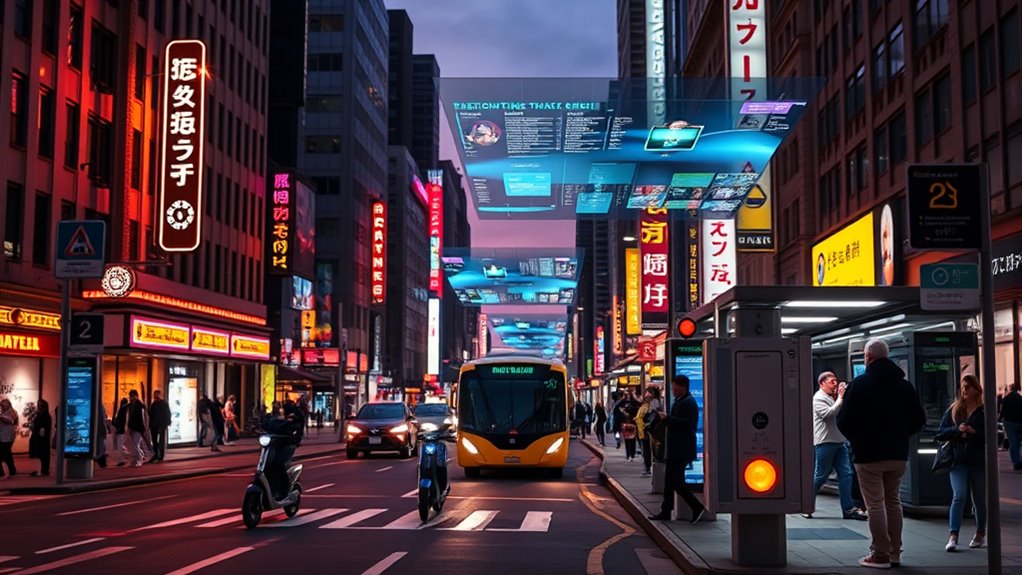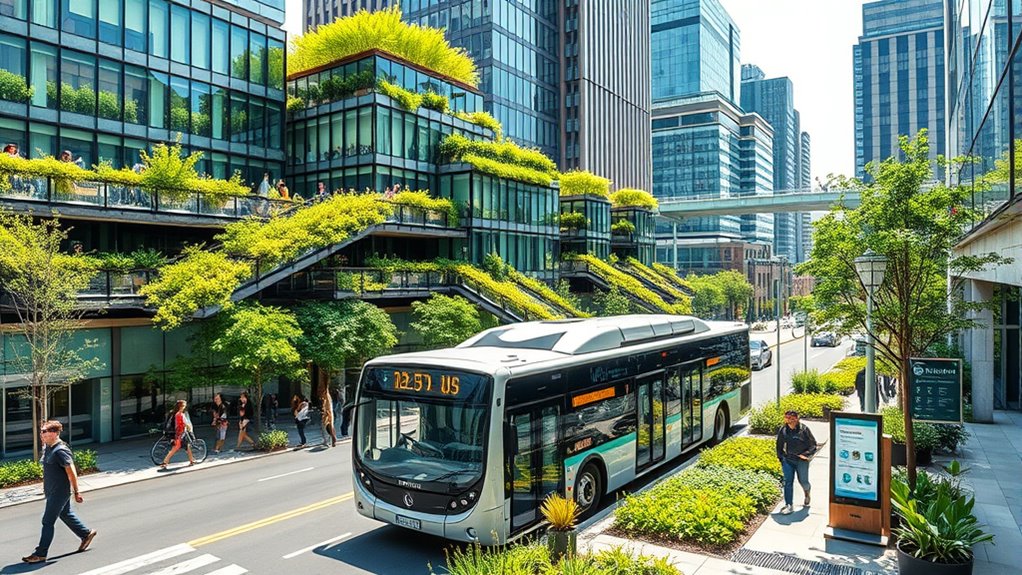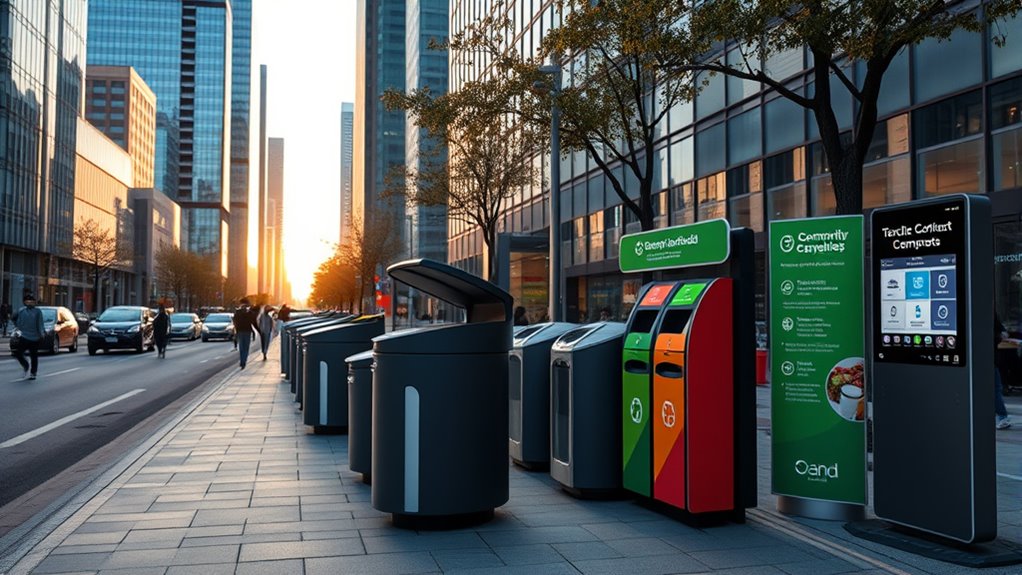Cities serve as dynamic laboratories by testing innovative solutions like expanding pedestrian zones, deploying autonomous shuttles, and transforming streets into green spaces. These prototypes have led to policy shifts toward greener, more walkable, and tech-enabled urban environments. Data-driven public space management and smart waste systems also influence regulatory changes. If you keep exploring, you’ll discover inspiring ways cities turn prototypes into lasting policies that shape healthier, more sustainable places for everyone.
Key Takeaways
- Urban prototypes like green infrastructure and smart mobility trials demonstrate tangible benefits, prompting policy adoption and scaling citywide.
- Data-driven pilots using sensors and AI have improved public safety and traffic management, influencing regulatory frameworks.
- Waste management innovations, such as smart recycling and zero-waste policies, originated from prototypes and reshaped urban waste policies.
- Pilot projects integrating green spaces and renewable energy have driven policy shifts towards sustainability and resilient urban design.
- City-led prototyping efforts foster stakeholder engagement, providing evidence that informs long-term urban planning and legislative changes.
Smart Mobility Trials Transforming Urban Transit

Smart mobility trials are reshaping urban transit by testing innovative solutions that make transportation more efficient and sustainable. One major development involves expanding pedestrian zones, which prioritize foot traffic and reduce vehicle congestion. These zones create safer, more inviting spaces for pedestrians while encouraging local commerce. Alongside this, autonomous shuttles are being deployed to serve these areas, providing seamless, contactless transportation options. You might see self-driving shuttles navigating restricted zones, offering convenient rides without the need for human drivers. These trials help cities gather valuable data on traffic flow, safety, and user experience. By integrating pedestrian zones with autonomous shuttles, urban areas can reduce pollution, improve accessibility, and foster more walkable, lively neighborhoods. Smart mobility is a key factor driving this transformation, making city transit more adaptable and user-centric. This innovative approach is transforming how you experience city transit daily.
Green Infrastructure Pilots Promoting Eco-Friendly Cities

You can see how green space trials transform urban areas into healthier environments, offering residents places to relax and connect with nature. Eco-friendly urban designs incorporate sustainable materials and innovative layouts that reduce pollution and conserve resources. These pilots demonstrate how cities can lead the way in creating eco-conscious communities. For example, implementing green infrastructure solutions like rain gardens and permeable pavements enhances environmental resilience.
Green Space Trials
Green space trials are gaining momentum as cities recognize the benefits of integrating green infrastructure into urban environments. You might participate in urban forestry projects that plant trees to improve air quality and provide shade. These initiatives help create cooler, more breathable cities while enhancing biodiversity. Parklet experiments transform small street spaces into green oases, offering residents areas for relaxation and socializing. By repurposing parking spots into lush, accessible green spaces, cities promote community well-being and environmental resilience. These trials serve as practical prototypes, demonstrating how small-scale interventions can lead to broader policy changes. Additionally, cultivating attention during these projects can enhance community engagement and the quality of creative problem-solving involved. As you observe these efforts, you’ll see how green space trials foster sustainable urban growth, making cities healthier, more livable, and better equipped to tackle climate challenges.
Eco-Friendly Urban Designs
Eco-friendly urban designs are transforming cityscapes through innovative green infrastructure pilots that prioritize sustainability and resilience. You can see this in urban farming initiatives that turn rooftops and vacant lots into productive green spaces, reducing food miles and increasing local food security. These projects not only support eco-friendly living but also improve air quality and urban biodiversity. Additionally, cities are adopting renewable energy solutions like solar panels and wind turbines integrated into building designs, decreasing reliance on fossil fuels. These eco-friendly urban designs demonstrate how cities can promote sustainability while enhancing residents’ quality of life. By embracing green infrastructure pilots, you help create resilient urban environments that balance development with ecological preservation, paving the way for more sustainable, eco-conscious cities. Incorporating renewable energy sources into urban planning is essential for long-term environmental benefits.
Data-Driven Public Space Management Initiatives

Cities are increasingly harnessing data to optimize public space management, transforming how urban areas respond to residents’ needs. By analyzing pedestrian flow, city planners can adjust street layouts, seating arrangements, and lighting to improve safety and accessibility. Public space optimization relies on real-time data collected from sensors, cameras, and mobile devices, providing insights into peak usage times and crowded areas. This approach allows for proactive management, reducing congestion and enhancing user experience. For example, dynamic signage can guide pedestrians away from overcrowded zones, while maintenance can be scheduled during low-traffic periods. Incorporating contrast ratio considerations into lighting and display design can further improve visibility and safety during nighttime hours. By leveraging these data-driven strategies, cities create more efficient, welcoming environments that adapt to changing demands, ultimately fostering vibrant, accessible urban spaces that serve everyone better.
Innovative Waste Management Solutions in Action

You can see cities adopting smart waste sorting technologies that streamline recycling processes and reduce contamination. Community-led recycling initiatives empower residents to take an active role in waste reduction, making a real impact. Zero-waste policies push urban areas toward sustainability, challenging you to rethink waste as a resource rather than a problem. Additionally, integrating best practices in dog training can foster responsible pet ownership and community harmony.
Smart Waste Sorting Tech
How are cities transforming waste management with technology? Smart waste sorting tech streamlines recycling education by providing real-time feedback and guiding residents on proper disposal. Sensors and AI-powered bins automatically identify and sort recyclables from waste, reducing contamination and increasing efficiency. These systems also optimize waste collection scheduling, ensuring pickups happen only when bins are full, saving resources and lowering costs. By integrating data analytics, cities can predict waste patterns and adjust services proactively. This technology encourages responsible behavior while making waste management more sustainable. It minimizes human error and speeds up recycling processes. Additionally, implementing privacy policies ensures that data collected from these systems is managed responsibly. Overall, smart waste sorting tech creates cleaner, more efficient urban environments, fostering better recycling habits and smarter resource use.
Community Recycling Initiatives
Community recycling initiatives are transforming waste management by empowering residents to take an active role in sustainability efforts. By fostering community engagement, cities encourage residents to participate in local recycling programs and share best practices. Recycling education plays a vital part, equipping individuals with the knowledge to sort waste correctly and understand its environmental impact. These initiatives often include workshops, outreach campaigns, and accessible drop-off points, making recycling more approachable. When you get involved, you help reduce landfill waste and support circular economies. Cities that prioritize community-led recycling programs see higher participation rates and cleaner neighborhoods. Your active engagement not only strengthens community bonds but also advances city-wide sustainability goals, demonstrating how grassroots efforts can lead to meaningful policy change. The commitment to transparency in sourcing and manufacturing processes ensures that these initiatives are built on trust and quality.
Zero-Waste Urban Policies
Zero-waste urban policies are reshaping how cities handle waste by implementing innovative strategies that aim to eliminate landfill contributions entirely. You’ll find cities promoting recycling incentives that motivate residents to sort and recycle more effectively. These policies often include extensive waste reduction campaigns that encourage reducing overall waste production. By focusing on source separation and reusing materials, cities minimize the need for landfills and incineration. Innovative programs, such as community composting and digital waste tracking, make waste management transparent and participatory. These initiatives not only reduce environmental impact but also foster a culture of sustainability. Additionally, integrating sustainable materials into city infrastructure helps reduce dependency on single-use products and supports circular economy principles. As a result, cities become models of circular economies, proving that strategic policy design and public engagement can lead to zero-waste communities.
Pilot Programs for Affordable and Inclusive Housing

Cities are increasingly implementing pilot programs to create affordable and inclusive housing, aiming to address growing housing shortages and unequal access. These initiatives test innovative strategies to boost social equity, ensuring diverse populations can find suitable homes. You might see flexible zoning rules, temporary housing solutions, or partnerships with nonprofits designed to lower costs and expand options. By piloting these programs, cities gather real-world data on what works best for different communities. This approach allows for rapid adjustments before scaling successful models citywide. These efforts often prioritize marginalized groups, helping reduce disparities in housing access. Incorporating versatile urban solutions can enhance the adaptability of these programs to different city environments. Ultimately, these pilot programs serve as urban laboratories that inform long-term policies, making cities more equitable, resilient, and welcoming for everyone.
Technology-Enabled Safety and Emergency Response Experiments

Advances in technology are transforming how urban areas respond to safety concerns and emergencies. City officials now deploy real-time data analysis, sensors, and AI-powered systems to improve response times and coordinate resources efficiently. Drones and surveillance cameras provide instant situational awareness, saving lives during crises. However, these innovations raise privacy concerns, especially around data privacy and surveillance overreach. Citizens worry about how their personal information is collected, stored, and used. To balance safety and privacy, cities experiment with anonymized data and transparent policies. These urban prototyping efforts demonstrate that technology can enhance emergency responses while respecting individual rights. By addressing privacy concerns head-on, cities create safer environments without compromising trust or civil liberties.
Frequently Asked Questions
How Do Urban Prototypes Influence Long-Term City Planning Strategies?
Urban prototypes influence long-term city planning strategies by showcasing innovative solutions that can be tested and refined in real environments. You see how urban innovation drives policy integration, encouraging policymakers to adopt flexible, scalable approaches. These prototypes provide valuable data and experiences, guiding future development. As a result, they help create more resilient, adaptable cities, ensuring that long-term strategies are grounded in practical insights and successful pilot projects.
What Funding Sources Support City-Led Prototyping Projects?
You can secure funding for city-led prototyping projects through public-private partnerships, which combine resources from government agencies and private sector players. Additionally, grant funding from government programs, foundations, or international organizations supports innovative urban solutions. These sources enable you to test ideas, gather data, and refine policies effectively, ensuring your projects have a lasting impact on urban development and community well-being.
How Do Residents Participate in City Prototyping Initiatives?
You can participate in city prototyping initiatives through public participation and community engagement efforts. Attend public meetings, workshops, or design charrettes to share your ideas and feedback. Many cities also use digital platforms to gather input from residents. By actively engaging, you help shape prototypes, ensuring they reflect community needs and priorities. Your involvement makes a difference, fostering more inclusive, effective urban solutions that serve everyone better.
What Metrics Are Used to Assess the Success of Urban Prototypes?
You should consider performance indicators like usability, safety, and environmental impact to assess urban prototypes. Community engagement is vital, so measuring participation levels and feedback helps determine success. You might also track how well prototypes address local needs and encourage collaboration. By combining these metrics, you get a clear picture of whether the urban prototype effectively improves city life and fosters meaningful involvement from residents.
How Do Prototypes Scale From Pilot to Permanent City Policies?
When scaling prototypes into permanent policies, you face scaling challenges like resource limits and infrastructure needs. You should actively involve community engagement to guarantee the solutions meet residents’ needs and gain public support. By gathering feedback, adjusting plans, and demonstrating success, you can overcome obstacles. Your focus on collaboration and adaptable strategies helps turn innovative prototypes into lasting policies that improve urban life.
Conclusion
So, as you watch cities turn into living labs, you might think they’re just testing ground for progress. But maybe, just maybe, these bold experiments show that change isn’t as simple as pushing a button. Instead, they prove that cities are willing to risk a few hiccups for a glimpse of a better future—one that’s often a little messier, yet somehow more innovative. After all, who said progress couldn’t be a little unpredictable?









